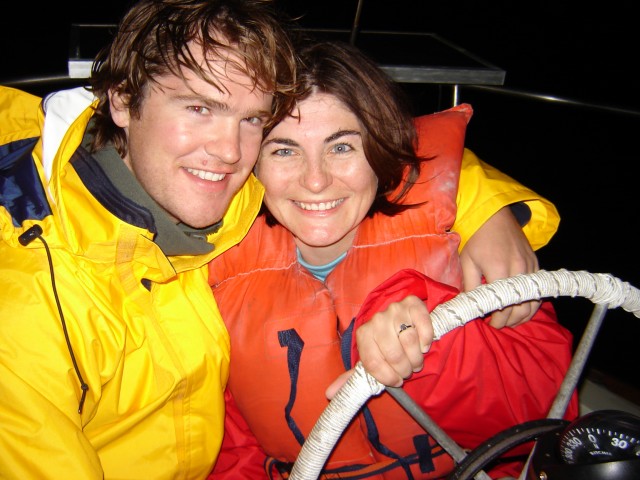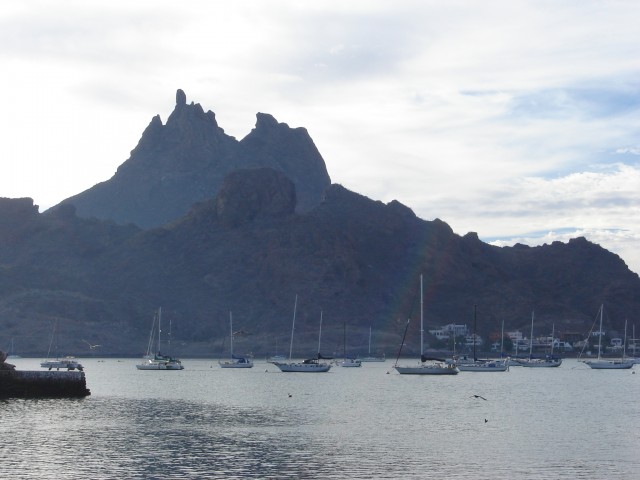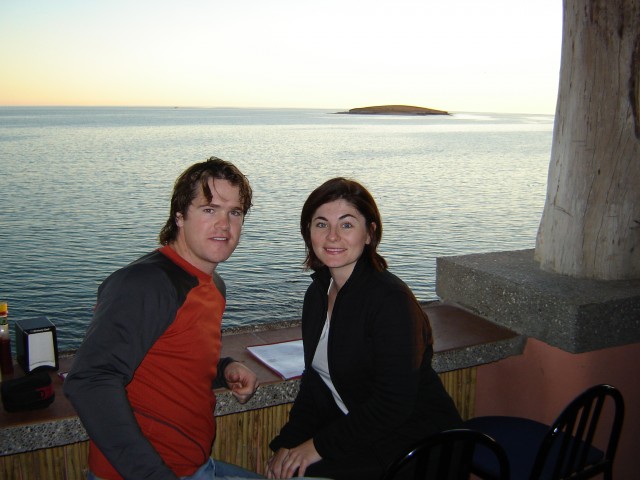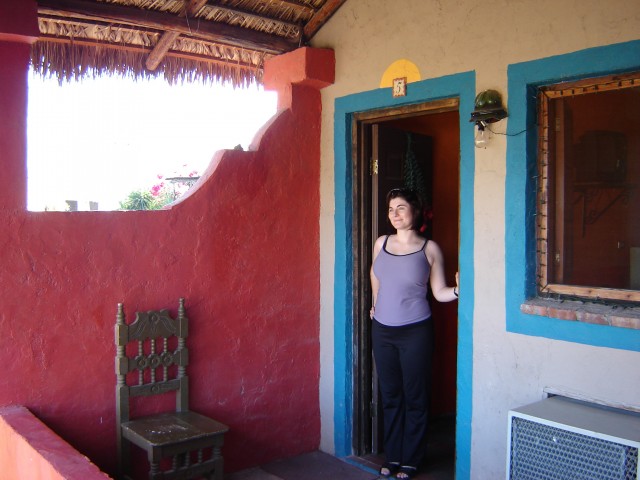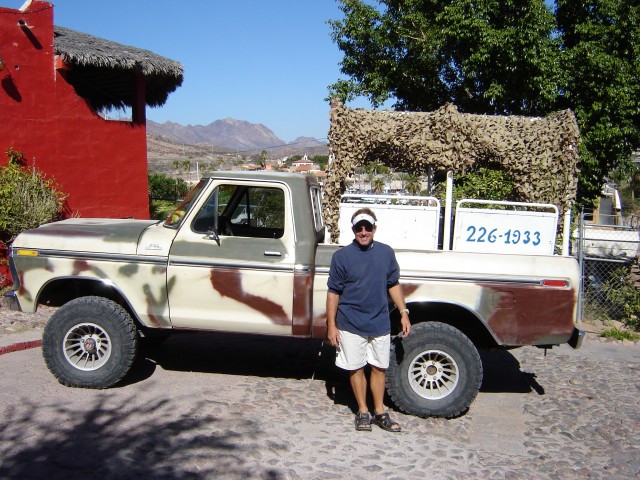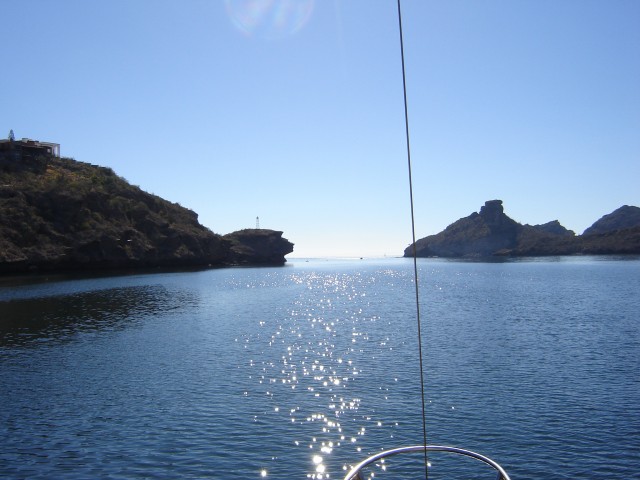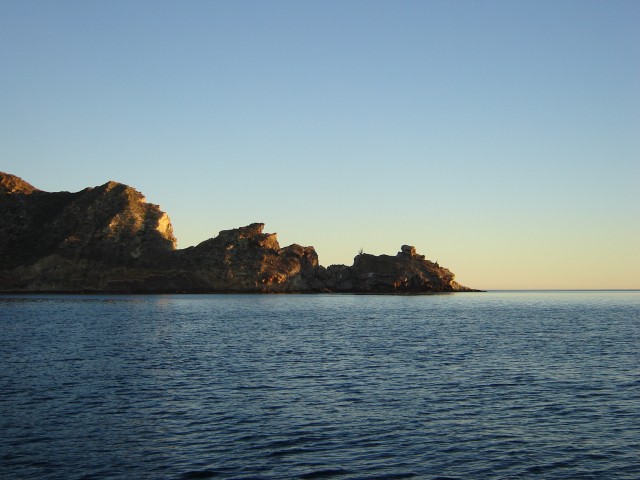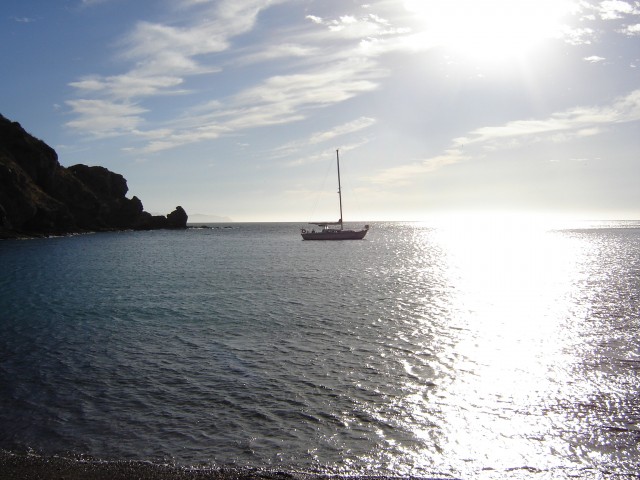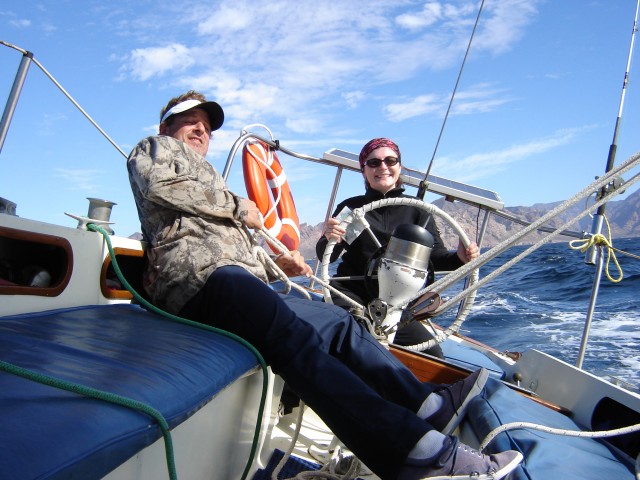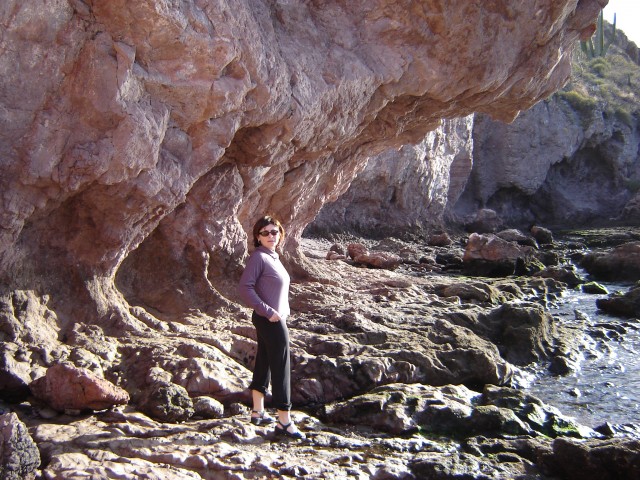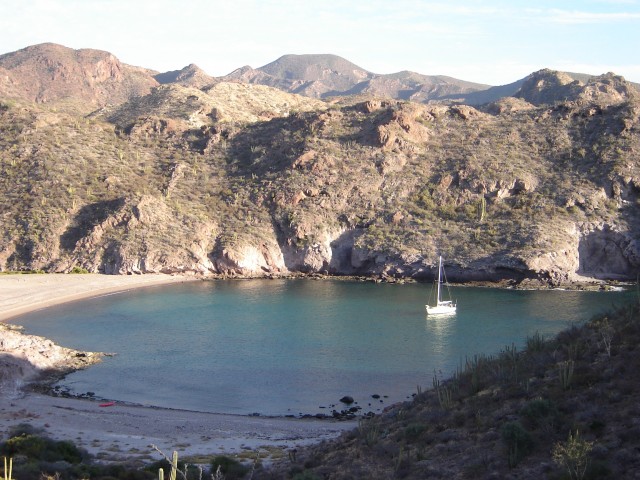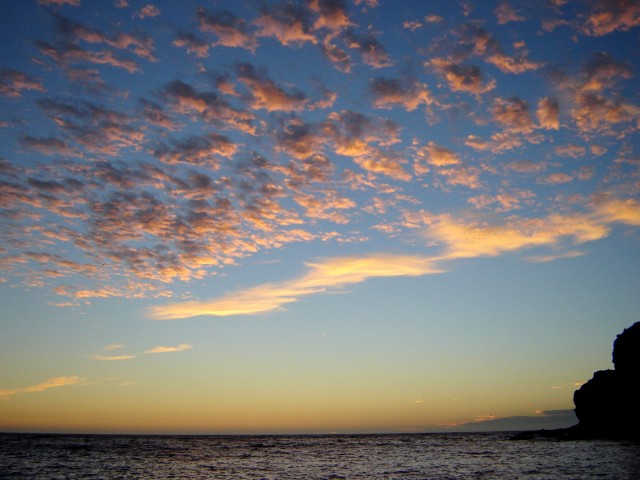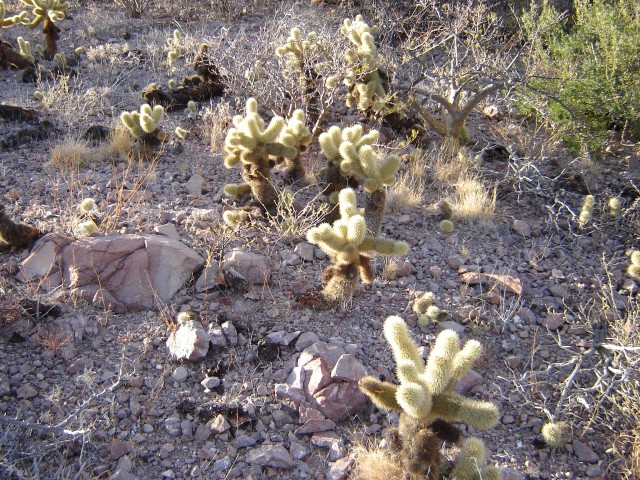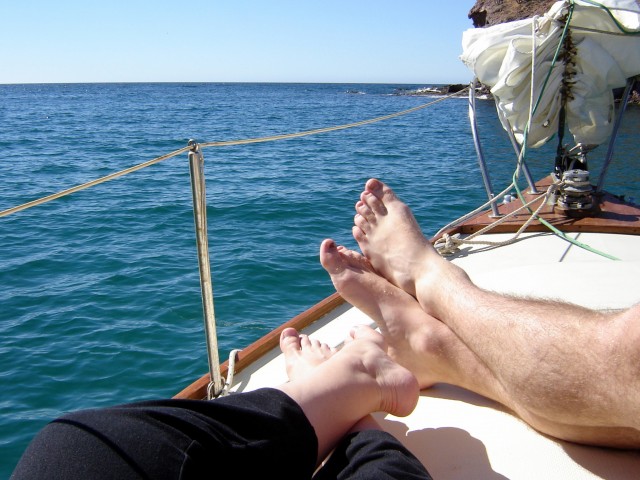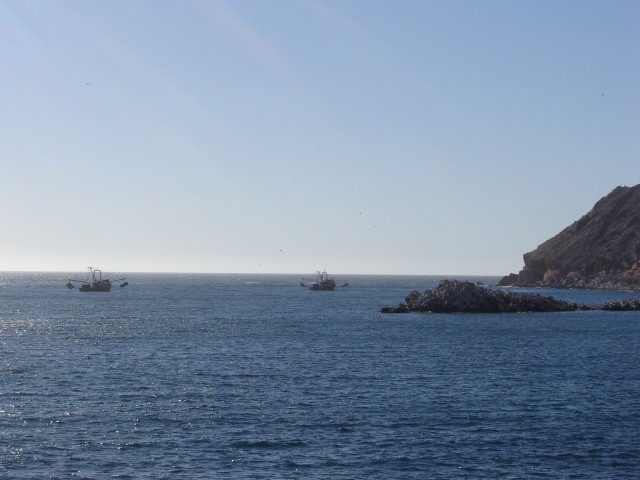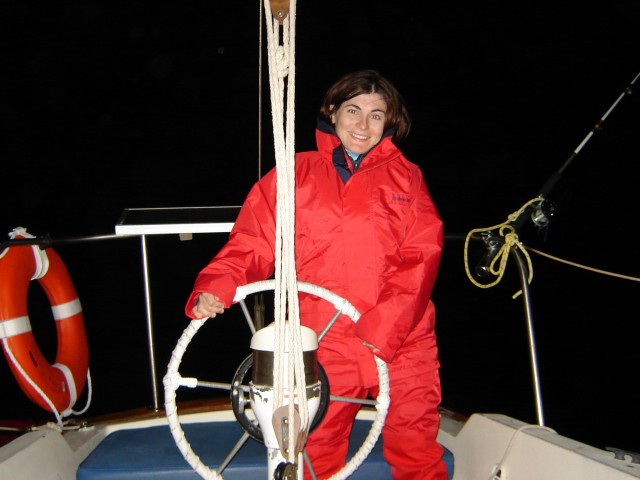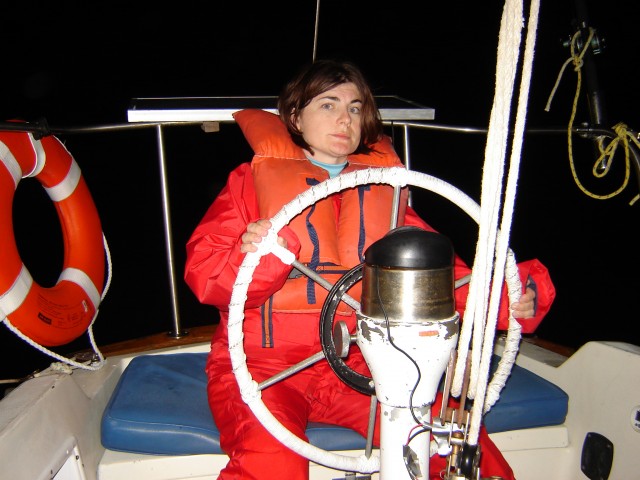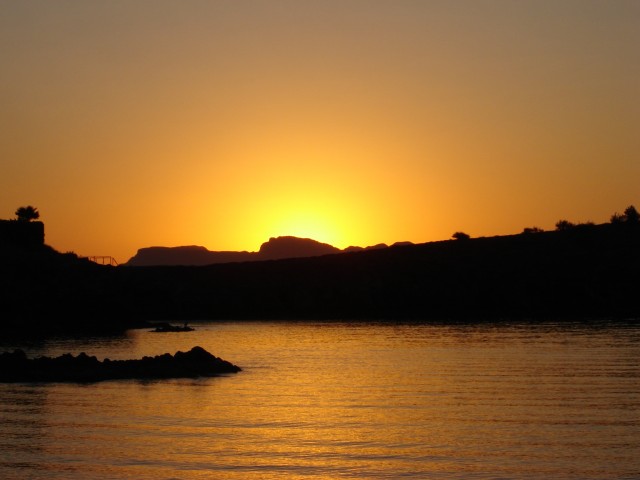Sara and I had been sailing around the SF Bay on our 27′ Ericson, but we really wanted to learn how to sail out in the ocean. We looked around and found the Sailing San Carlos website. We signed up a few weeks later for a five-day trip in the first week of 2006.
The trip was fantastic; we had a great time sailing and we also got engaged. This page covers the sailing portion, there’s a whole other page with sunset pictures and other engagement details.
Days 1-2: Arrive, Celebrate, Recover
We flew into Guaymas, Mexico and took the bus into San Carlos. We found a place to stay, did a bit of exploring, and celebrated New Years Eve in a perfect cabana with perfect margaritas.
Too perfect.
We hurt the next day. A lot.
We met David, our instructor, and the Free Spirit, a 34′ Coronado, the next day. We provisioned the boat and had a much more relaxing night on the town. Sara ordered a margarita and could only drink two or three sips. Ahahaha.
Day 3: Leaving San Carlos
We started early the next day with boat drills in the morning (docking, departing, motoring in tight places). There’s a funny story here, but Sara won’t let me write about it; you need to ask her yourself. We finished up and headed out from San Carlos into the Sea of Cortez!
We continued our sailing drills as we headed North up the coast. Tack, gybe, heave-to, sail trim, points of sail, man overboard drills, etc; stuff we’ve done before, but never out in the ocean. It makes a difference!
The weather was so clear we could see some of the Baja mountains more than 70 miles away! The winds were below 10 knots, and the sea was pretty calm. It was an easy day of sailing and the perfect start to what turned out to be some interesting weather.
Halfway through the day’s sail, we were talking when we each heard this funny blowing sound. I was wondering if it was a bad boat noise when Sara yelled “Whales!” We saw a pod of five or six, later identified as Gray Whales, surfacing and blowing less than a hundred yards from the boat.
A bit of chartwork and navigation helped us find the large protected cove where we would stay the first night. We anchored in 15ft of water with a nice sandy bottom. Anchoring is something you really want to do right- the 12,000lb boat is held in place with a dinky 35lb chunk of metal stuck in loose sand. With winds and tide changing all the time, it can get sketchy.
Sara and David took care of dropping, setting, checking, re-setting, and testing the anchor while I manned the helm. I had the easy job, and I somehow managed to get this job almost every time we anchored. Imagine that.
That night we had a fantastic dinner with some hot sauce hotter than anything I had ever tasted before. My ears were sweating. We watched the sun go down, had a cold beer, and talked sailing and told lies until bedtime.
Day 4: Sailing Drills
We woke up early to the howl of something dog-like, and unbelievably just a few minutes later saw a coyote loping along the beach, sniffing at this and that. He was replaced a few minutes later with the sight of a large bald eagle carrying a snake back to it’s brood. Too cool.
We headed out for more of the same: theory, sailing drills, practical stuff like resetting an anchor and navigation, and a bunch of relaxing as well. The wind was picking up to 15-18 knots, and the waves were building to 4-6ft. It was choppy and bit gusty, and we had a great time doing our MOB drills.
The Sea of Cortez is relatively narrow, and with the wind blowing from the North, waves are built up and pushed South all day long. The rise and fall of the tide complicates things, and can bunch the waves together much more than you would find out in the open ocean. We saw 6ft waves just a few seconds apart, which is actually worse than the standard 15ft swell on a 13-second period that you find outside the SF bay.
We worked our way further up the coast, navigating by unique shore features like mountains or small islands. I was surprised at how ‘flat’ the shore looks when you’re more than half a mile out. You can’t see inlets, coves, or even islands until you’re almost on top of them!
Our next spot was a little smaller than the huge bay we stayed in before, and it was much more difficult to find.
Sara and David set the anchor again, and we had another great night discussing theory, discussing cruising plans, etc.
Day 5: The Maelstrom (well, rough seas)
We didn’t sleep well. The spot we were in was protected, but the wind and waves built all night and rolled us around. We had breakfast and did a bit of exploring before heading North again. We kayaked onto shore and hiked around the beaches and small hills. The beaches are covered in shells, bones, and fish carcasses the Pelicans disgorge; the hills are covered in the most amazing cacti.
Back on the boat, we hauled the anchor, and headed out into the building maelstrom. Okay, ‘maelstrom’ is too dramatic, how about ‘rough seas’?.
The winds were now up above 25 knots, the waves had built to 10-12 feet, and they were stacked really close. We didn’t do many drills, just sailing was enough of a chore. We reefed the main and didn’t sail as aggressively to keep the amount of heel down.
It was an exciting and exhausting day. We did long tacks to lose as little headway as possible; the wind was blowing from the North, exactly the direction we wanted to go. This took us further out into the sea where the wind and waves were stronger.
We could no longer put the boat straight through the oncoming waves, we had to take them at a much more conservative angle. This also limited our headway and slowed down our progress.
As we crested each wave we would head up and surf down the back to pick up speed, then fall off and climb the face of the next one. Some of these waves were much taller than we had ever seen before, and they were much closer together. I would estimate one wave every seven seconds.
We had a couple of close calls where we needed to blow the mainsheet, and we spent the entire day with main and jib sheets in hand, ready to pop them loose if a big gust of wind hit at the wrong time. We were surprised a few times by waves coming in strange directions, and ended up taking them head-on and crashing through them.
We pushed hard near the end of the day to make it to the little anchorage we had picked out, and made it with about an hour to spare. It was a good thing we correctly estimated our sailing time; our backup spot was two hours downwind!
The cove was tiny, but perfect. It protected us from the rolling waves and from most of the wind. We set anchor, had dinner, and slowly relaxed from all the excitement.
Day 6: Rest
The next day was our rest day.
We woke up later than usual, had a slow breakfast, went ashore and explored, and had a nice relaxing swim.
We were very protected from both wind and waves, but we could see them raging further out. It blew hard all day; the shrimping boats were hiding in the big bay we were in – apparently it was too rough to go dredging.
David kayaked out to the shrimpers to see if they had any fish to sell us. They didn’t, and asked if we had any for them! The weather had been too bad for them to fish for the last few days, and they were starting to get pretty hungry.
While he was gone, Sara and I realized the boat was dragging towards some rocks, and reset the anchor. Normally this isn’t a problem, but the cove we were in was so small, if the wind blew us around while we were setting the anchor, we would have had to haul it up and start all over. It was stressful, but we handled it like pros.
Day 7: Night Sailing
We had another awesome dinner and prepared to head out. Yep, our last sail was going to be overnight, in the monster winds and waves, all the way back to San Carlos. We went over the plan again and again, making contingencies, worrying about the weather, and second-guessing ourselves until it was time to leave.
The trip back was awesome. The wind had died down a bit, but the waves were still huge. They seemed more like rollers than the sharp-faced breakers we had battled the day before. Still, it was cool to look behind you and see a huge dark mass with a cap of whitewater way up over your head coming towards you.
The moon lit the first portion of our journey, helpful when getting away from the shore, and set just after midnight. The stars were so bright and plentiful that we could still see the boat, the water, and each other. We also had bright points of phosphorescence sparking in our wake.
It was magical. The sleep exhaustion certainly made it seem even more special.
We nailed our plan, sailing at our one intended course from 10PM until 2AM, averaging 5 knots, then gybing and heading to San Carlos. We hit seven knots on the second tack, roaring along with the waves. It was exhilirating. Sara was sitting in the cockpit, calling out waves behind me as I steered.
We made it to San Carlos just before 6AM. I asked Sara to marry me as we sailed in. She said yes.
The trip was awesome fun; worth every penny. I can’t recommend David and the San Carlos Sailing School enough.

